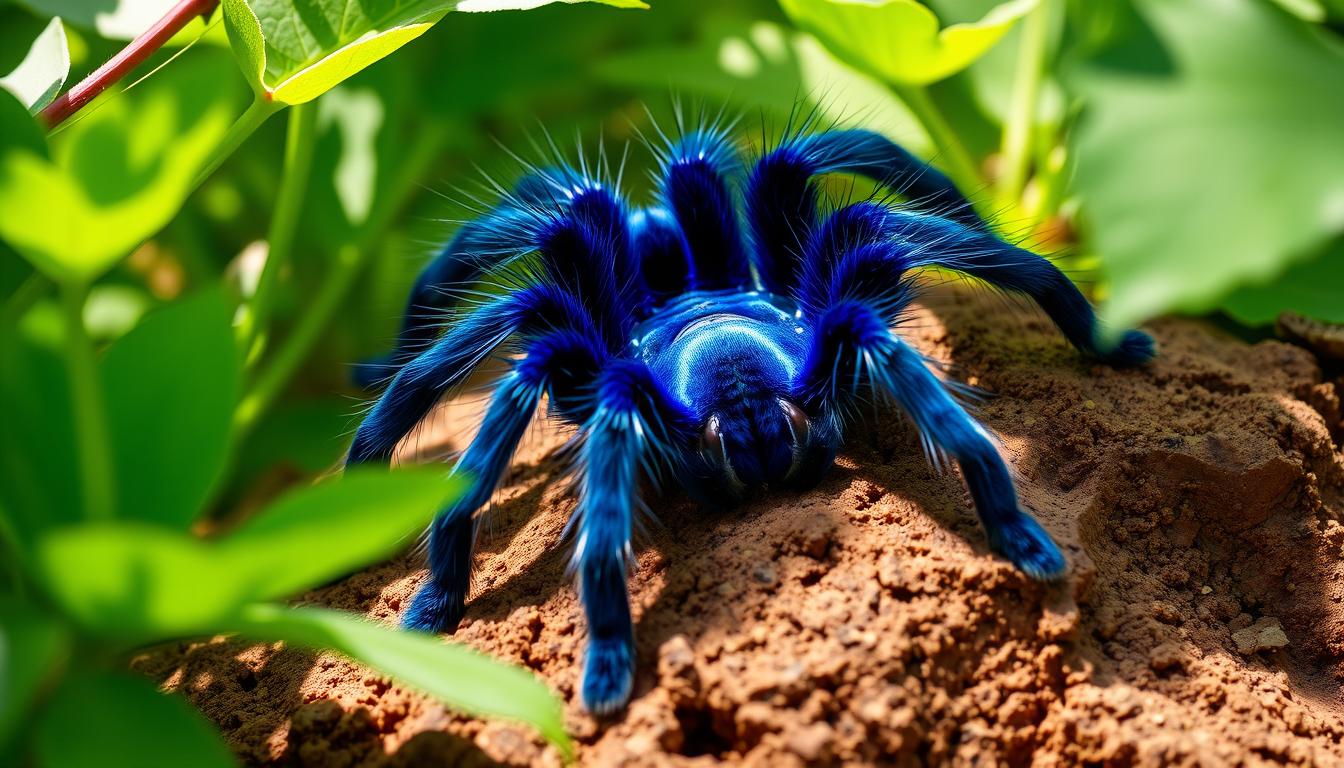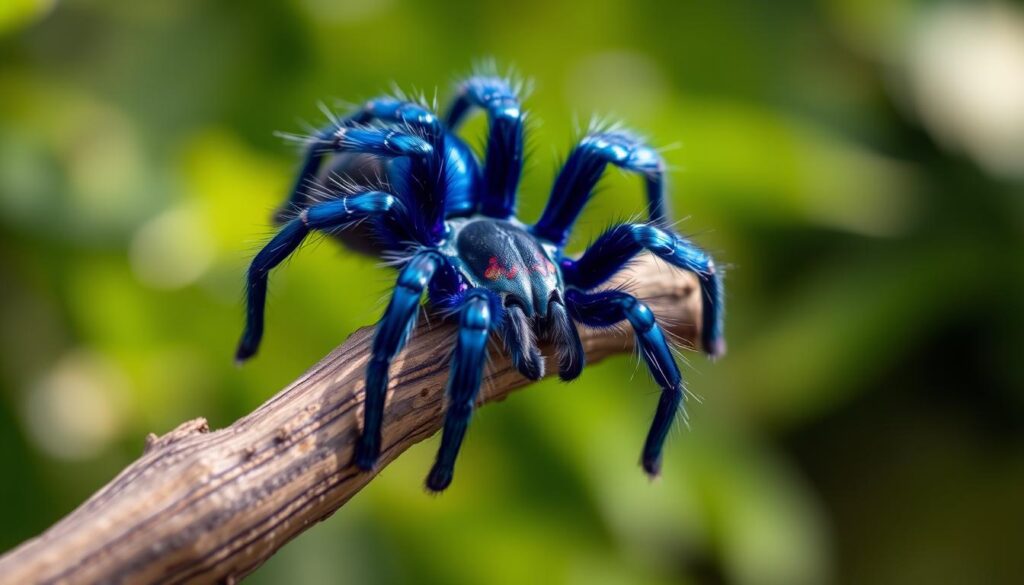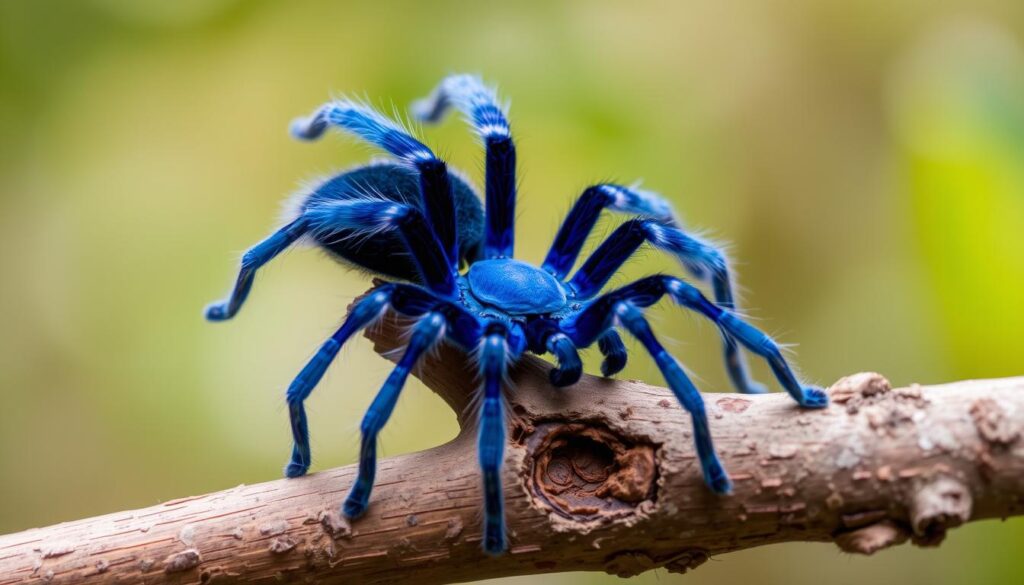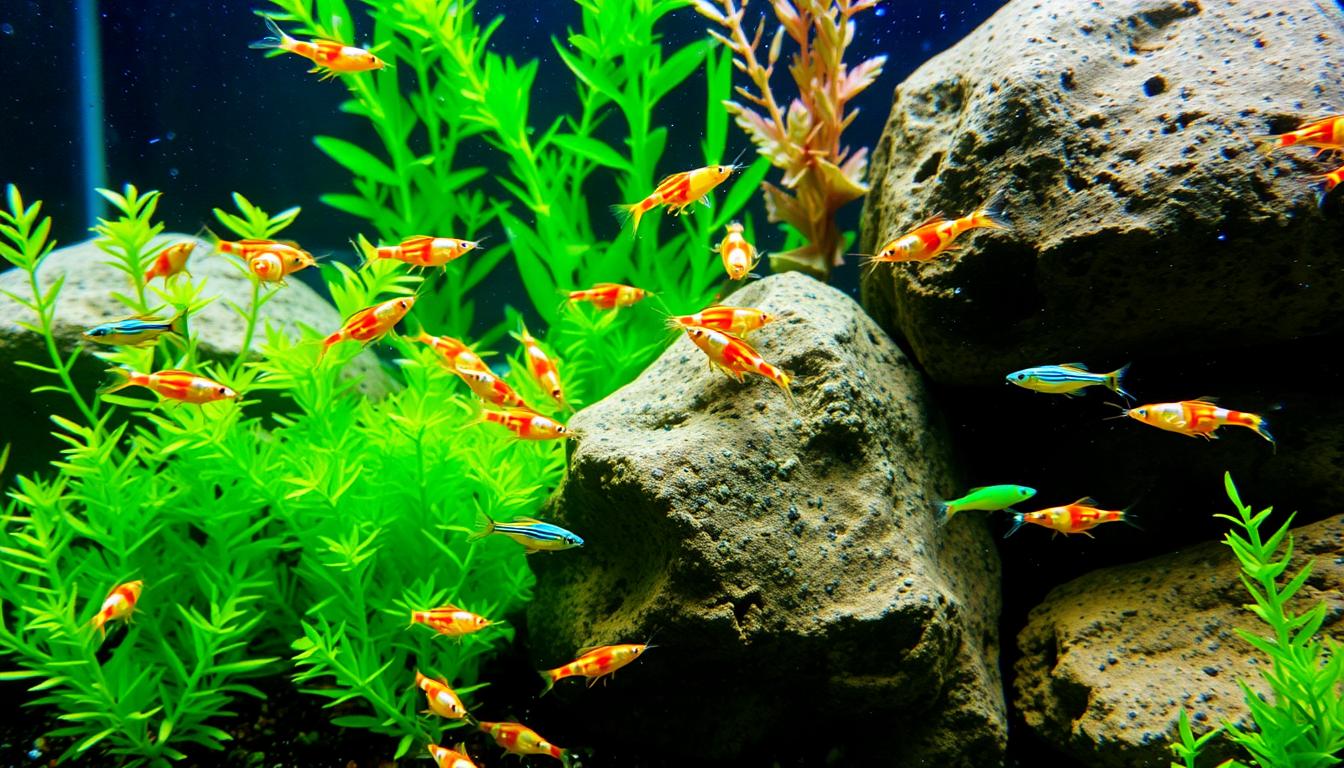Captivating Cobalt Blue Tarantula: Your Ultimate Pet Guide

Only about 4% of the 900 known tarantula species show blue coloring, making blue tarantulas rare1. If you’re thinking of getting a cobalt blue tarantula as a pet, it’s key to know their special traits and needs. This guide will help you understand how to care for them well.
Cobalt blue tarantulas are loved by many for their unique looks and behaviors. They make great pets with the right care. This guide will show you how to give your pet the best life.
Female Cobalt Blue Tarantulas can live up to 25 years in captivity. Males, however, live about 10 years1.
Key Takeaways
- Cobalt blue tarantulas are rare, with only about 4% of tarantula species exhibiting blue coloring1.
- They can live up to 25 years in captivity, making them a long-term exotic pet commitment1.
- A comprehensive tarantula care guide is necessary to provide the best life for your cobalt blue tarantula.
- Cobalt blue tarantulas have specific temperature and humidity requirements, between 26 to 32°C and 70-80%1.
- Feeding adult Cobalt Blue Tarantulas once every one to two weeks is generally sufficient1.
- Handling a Cobalt Blue Tarantula should be done with caution due to their defensive nature1.
Understanding the Cobalt Blue Tarantula Species
The cobalt blue tarantula is known for its striking look and unique traits. It comes from southeast Asia and lives in the tropical rainforests. The tarantula habitat there is perfect for them. They have an average leg span of 13 cm, with iridescent blue legs and light gray body parts2.
These tarantulas have a special look that makes them stand out. Their venom has certain compounds, including glutamic acid and histamine2. They live in the tropical rainforests of Southeast Asia, where it’s humid and warm3.
Some key traits of the cobalt blue tarantula include:
- Average leg span of around 13 cm2
- Native to southeast Asia, inhabiting tropical rainforests2
- Distinctive appearance, with iridescent blue legs and light gray prosoma and opisthosoma
- Venom contains glutamic acid, histamine, and adenosine, with trace amounts of polyamine spermine2
The cobalt blue tarantula is a unique and interesting species. It’s popular among tarantula fans. With the right care, these spiders can do well in captivity, making them a great pet choice3.
Why These Stunning Arachnids Make Unique Pets
The cobalt blue tarantula is a captivating exotic pet for those looking for something special4. With over 1,000 tarantula species, you can find ones that are quite large, up to 10 inches or more4. It’s important to keep their environment right, with a temperature of 70-85°F4.
Keeping a cobalt blue tarantula is relatively easy. They eat live insects like crickets and mealworms4. They can also survive for a while without food, which is great for busy people. Here are some reasons why they make great pets:
- Low-maintenance care requirements
- Adaptability to different environments
- Fascinating behaviors and lifecycles
With the right care, these pets can live up to 20 years4. They are perfect for both experienced and new pet owners. The cobalt blue tarantula is a unique and interesting pet choice.
Essential Housing Requirements
Creating a good tarantula habitat for your cobalt blue tarantula is key. The terrarium size and setup are very important. They affect your pet’s health and happiness. For adult cobalt blues, a habitat with about 8 inches of moist substrate is best5.
This depth lets them burrow and dig, which is natural for them.
Temperature and humidity are also crucial. Keep the temperature between 78 and 84 degrees Fahrenheit. The humidity should be between 70 and 80 percent5. This makes a comfy home for your tarantula and keeps it healthy.
The substrate’s type and depth matter a lot. A deep, moist substrate lets them burrow and dig. This is good for their physical and mental health.
Some important things to think about for a good tarantula habitat are:
- Give a big terrarium with lots of substrate for burrowing.
- Keep the temperature between 78 and 84 degrees Fahrenheit.
- Make sure the humidity is between 70 and 80 percent.
- Provide hiding spots and climbing structures for natural behaviors.
By following these tips and knowing what your cobalt blue tarantula needs, you can make a great home. This home will meet the highest standards oftarantula care6.
The Striking Beauty of Cobalt Blue Tarantulas

The cobalt blue tarantula is a stunning example of the tarantula species. It is known for its striking appearance. This includes iridescent blue legs and a light gray body7. As an exotic pet, it is prized for its unique features and characteristics.
One of the most notable aspects of this species is its coloration. Females display a vibrant blue hue. On the other hand, males and juveniles have a more subdued coloration7.
Some interesting facts about the cobalt blue tarantula include:
- They are native to Thailand and Burma7
- They are considered short-haired and short-tempered, making them generally not handleable7
- They are categorized as an arboreal species that is an extensive webber3
When it comes to caring for a cobalt blue tarantula as an exotic pet, it’s essential to provide the right environment. This includes a temperature range of 75 to 85°F (24 to 29°C) and a humidity range of 75-85%3. With proper care and attention, the cobalt blue tarantula can thrive. It makes a rewarding and unique pet for those interested in tarantula species.
Feeding Your Cobalt Blue Tarantula
As a responsible owner of an exotic pet like the cobalt blue tarantula, it’s essential to understand their feeding requirements. Cobalt blue tarantulas are carnivorous predators, feeding primarily on live insects such as crickets, roaches, and mealworms8. It’s crucial to provide a balanced diet that meets their nutritional needs.
A suitable feeding schedule for your cobalt blue tarantula would be to feed them once or twice a week, as they can fast for months at a time8. It’s also important to note that tarantulas obtain water intake from the insects they consume, but a water bowl should be available8. The preferred prey items for cobalt blue tarantulas include live insects like cockroaches, crickets, and worms8.
Here are some key points to consider when feeding your cobalt blue tarantula:
- Feed them live insects like crickets, roaches, and mealworms8
- Feed them once or twice a week, as they can fast for months at a time8
- Provide a water bowl, although they obtain water from the insects they consume8
Remember, proper tarantula care, including feeding, is essential for the health and well-being of your exotic pet, such as the cobalt blue tarantula9. By following these guidelines and providing a balanced diet, you can ensure that your pet tarantula thrives and lives a long, healthy life. This makes them a wonderful and unique addition to the world of exotic pets10.
Behavioral Traits and Temperament

The cobalt blue tarantula is known for being defensive and aggressive when threatened or cornered11. As an exotic pet, it’s vital to respect their boundaries for a safe and healthy relationship. Their behavior is shaped by their natural habitat, so it’s important to mimic their environment in captivity.
The Avicularia genus, which includes the cobalt blue tarantula, comes in various colors and patterns12. This includes orange, blue, and metallic hues, appealing to different pet owners. Some species, like A. huriana, are the largest in the genus, attracting enthusiasts of bigger spiders12.
Here are some key things to consider when caring for a cobalt blue tarantula:
- Provide a suitable enclosure that mimics their natural habitat
- Maintain a consistent temperature and humidity level
- Offer a varied and nutritious diet
- Handle them gently and with care, avoiding sudden movements
Understanding and respecting the tarantula behavior and temperament of the cobalt blue tarantula is crucial. This way, you can create a safe and enjoyable space for both you and your exotic pet. Always prioritize their well-being and take necessary precautions when handling them11.
Health and Wellness Monitoring
As a cobalt blue tarantula owner, it’s key to watch your pet’s health closely. Look out for common problems like breathing issues and fungal infections13. Good care, like the right home and food, can stop these problems.
Regular checks can spot issues early. This means quick treatment and avoiding bigger problems. Also, know the signs of stress, like eating less or acting differently, and try to reduce stress.
Common Health Issues
Issues like breathing problems, fungal infections, and parasites can affect cobalt blue tarantulas. It’s important to get help from a vet who knows tarantulas well for quick diagnosis and treatment.
By focusing on your tarantula’s health, you can make sure it lives a long, happy life. For more on animal health, check out petpawza.com. They talk about the value of regular vet visits and proper care.
Molting Process
The molting process is a natural part of a tarantula’s life. Understanding and supporting it is crucial for your pet’s health. With the right care, your cobalt blue tarantula can do well.
| Health Issue | Symptoms | Treatment |
|---|---|---|
| Respiratory problems | Difficulty breathing, wheezing | Veterinary care, antibiotics |
| Fungal infections | Discoloration, lesions | Veterinary care, antifungal medication |
A healthy cobalt blue tarantula is a happy one. By focusing on your pet’s health, you’ll have a rewarding bond with it.
Safe Handling Practices and Precautions
Handling tarantulas safely is crucial. Cobalt blue tarantulas can be aggressive if they feel threatened or cornered14. It’s important to know how to handle them to avoid bites.
Being gentle and calm is key when handling your tarantula. Sudden movements can make them attack. Also, watch for signs like raised abdomens or fangs, which mean they’re scared14.
For more pet safety tips, check out petpawza.com. By following these safety steps, you can enjoy a safe and happy time with your tarantula.
Here are some more tips for safe handling:
* Handle your tarantula gently and calmly.
* Don’t make sudden moves or loud noises.
* Keep their home clean and well-kept.
* Make sure their living space is safe and secure.
| Tarantula Handling Tips | Safety Precautions |
|---|---|
| Be gentle and calm | Avoid sudden movements |
| Keep the enclosure clean | Provide a safe environment |
Breeding and Reproduction Basics
Understanding the biology and behavior of tarantulas is key for tarantula breeding15. The cobalt blue tarantula is a favorite among breeders. Its breeding process is quite complex. To breed them well, knowing the size range of pet tarantulas is important. They can be from 2.5 cm to 30 cm in legspan, depending on the species16.
Here are some important things to think about for tarantula breeding:
- Creating a good environment for them, like a terrarium with the right temperature and humidity
- Making sure they are well-fed and healthy, with a diet of insects and small rodents
- Knowing their temperament, as they can be calm but get aggressive if scared
The reproduction of cobalt blue tarantulas is interesting. The male makes a sperm web, and the female picks it up with her pedipalps15. This whole process needs careful planning and attention for success. By knowing how these creatures work, breeders can do better in tarantula breeding and reproduction.
Maintenance and Regular Care Schedule
As a cobalt blue tarantula owner, it’s key to have a care routine. This ensures your pet stays healthy and happy. The first source says cobalt blue tarantulas need regular care17. This includes daily tasks and monthly cleaning.
For daily care, check the temperature and humidity. Also, make sure they have fresh water and food. The best temperature is around 25°C, with a slight drop at night17. Use a thermometer and hygrometer to keep these levels right. For more tips, visit ReptiChip’s blog on cobalt blue tarantulas.
Daily Care Routine
Here are some daily tasks to include in your routine:
- Check temperature and humidity levels
- Provide fresh water and food
- Clean the food and water dishes
Monthly Maintenance Tasks
Monthly tasks should include:
- Cleaning the enclosure
- Replacing the substrate
- Checking for any signs of illness or stress
By sticking to a regular care schedule, you can keep your cobalt blue tarantula healthy. Always do your research and talk to experts for the best care18.
Conclusion: Is a Cobalt Blue Tarantula Right for You?
Exploring the world of cobalt blue tarantulas shows they need special care. Their bright blue color and interesting behavior are tempting. But, they’re not for beginners19.
These tarantulas need owners who know how to care for them properly. They can be dangerous because of their defensive nature and tendency to bite multiple times19. It’s safer to start with easier-to-care-for tarantulas for beginners20.
Deciding if a cobalt blue tarantula is right for you depends on your expertise in exotic pets. If you’re ready to learn and provide the right care, they can be great pets. But, they’re not for the timid1920.
FAQ
What is a cobalt blue tarantula?
Where do cobalt blue tarantulas live in the wild?
What are the physical characteristics of cobalt blue tarantulas?
How long do cobalt blue tarantulas live?
Why are cobalt blue tarantulas popular as pets?
What are the essential housing requirements for cobalt blue tarantulas?
What do cobalt blue tarantulas eat?
How do cobalt blue tarantulas behave?
What are some common health issues in cobalt blue tarantulas?
How can I safely handle a cobalt blue tarantula?
Can cobalt blue tarantulas be bred?
What is a typical daily and monthly care routine for a cobalt blue tarantula?
Source Links
- https://www.catbreedslist.com/stories/faqs-about-cobalt-blue-tarantulas.html – 10 FAQs About Cobalt Blue Tarantulas
- https://en.wikipedia.org/wiki/Cobalt_blue_tarantula – Cobalt blue tarantula
- https://www.urbantarantulas.com/products/cyriopagopus-lividus-cobalt-blue-tarantula – Cyriopagopus lividus – cobalt blue tarantula
- https://avalonexotics.com/spotlight-on-tarantulas-care-personality-and-fun-facts/ – Spotlight on Tarantulas: Care, Personality, and Fun Facts – Avalon Exotics
- https://topflightdubia.com/cobalt-blue-tarantula-care – Cobalt Blue Tarantula: Care Mastery
- https://www.thetarantulacollective.com/caresheets/cyriopagopus-lividus – Cyriopagopus lividus — The Tarantula Collective
- https://arachnoboards.com/threads/colbalt-blue-or-orange-baboon.9530/ – Colbalt Blue Or Orange Baboon
- https://salmanzafar.me/perfect-diet-for-cobalt-blue-tarantula/ – The Perfect Diet for Your Cobalt Blue Tarantula
- https://thespiderroom.wordpress.com/species/cobalt-blue-tarantula/ – Cobalt Blue Tarantula
- https://www.juicesarthropods.com/shop/p/cyriopagopus-lividus-cobalt-blue-tarantula – Buy Cyriopagopus lividus (Cobalt Blue Tarantula) — Juice’s Arthropods
- https://www.thetarantulacollective.com/caresheets/lampropelma-violaceopes – Singapore Blue Tarantula (Omothymus / Lampropelma violaceopes) Care — The Tarantula Collective
- https://www.lawngrass-seed.com/species.html – No title found
- https://hydrapple.com/a-comprehensive-care-guide-for-your-cobalt-blue-tarantula/ – A Comprehensive Care Guide for Your Cobalt Blue Tarantula
- https://assist.asta.edu.au/question/4365/agar-plate-setting-conditions-storage-inoculation-and-disposal – Agar plate setting conditions, storage, inoculation and disposal
- https://mantidforum.net/threads/cobalt-blue-threat-display.14446/latest – Cobalt Blue Threat Display
- https://www.mypets.net.au/pet-tarantula/ – Pet Tarantula – Pets Australia
- https://www.keepingexoticpets.com/cobalt-blue-tarantulas/ – Cobalt Blue Tarantula (Cyriopagopus lividus) Caresheet
- https://www.whingewhingewine.co.uk/tarantulas-as-pets.html – Tips for keeping and caring for your pet tarantula
- https://arachnoboards.com/threads/is-my-cobalt-blue-sick.229212/ – Is my Cobalt Blue sick?
- https://arachnifiles.com/cyriopagopus-lividus/ – Cyriopagopus lividus – Arachnifiles



